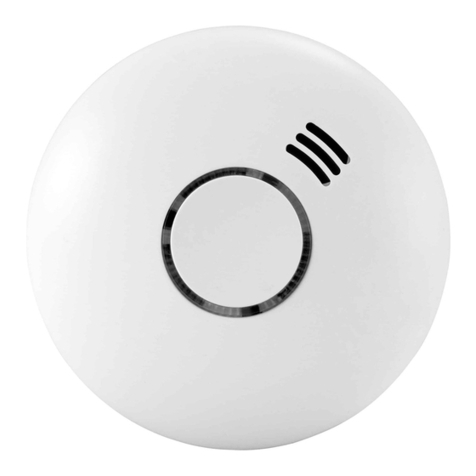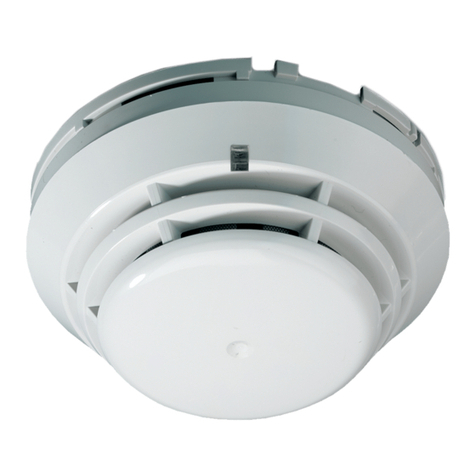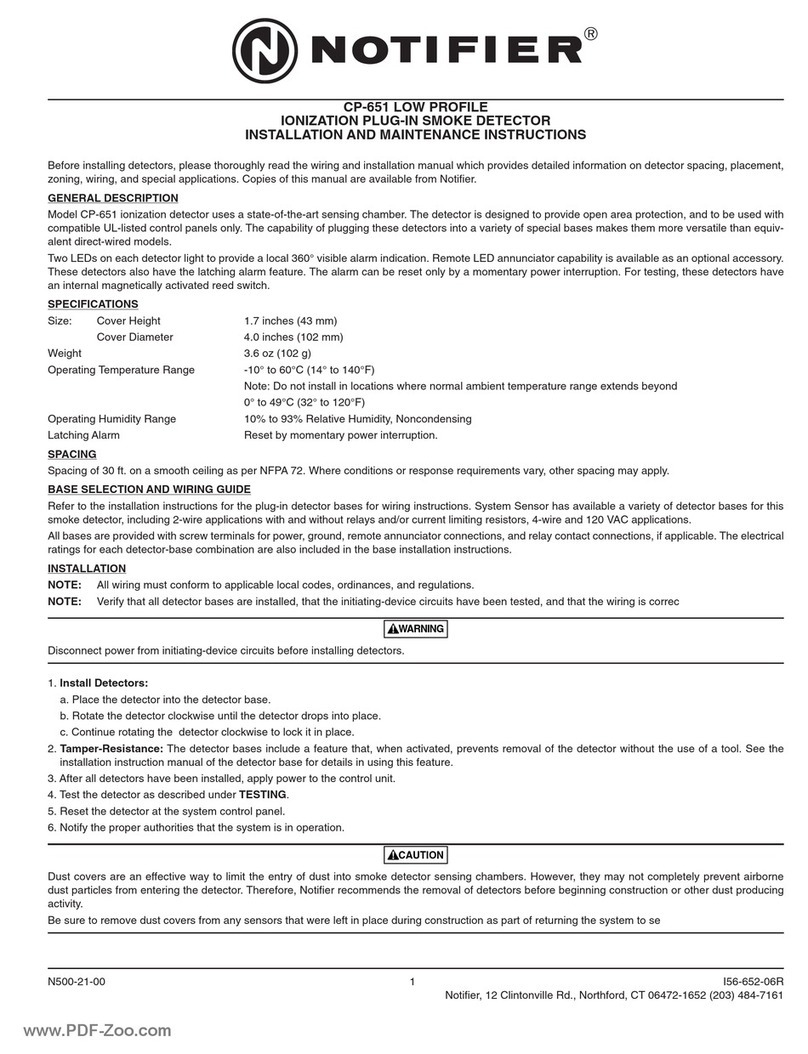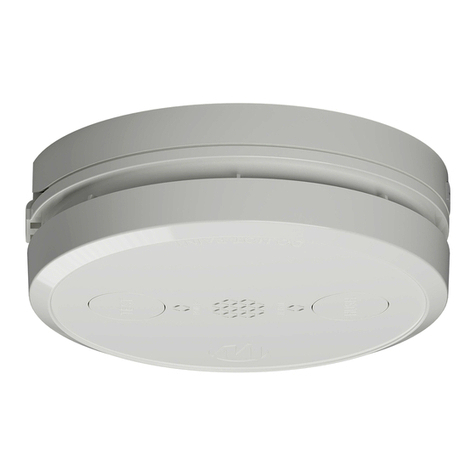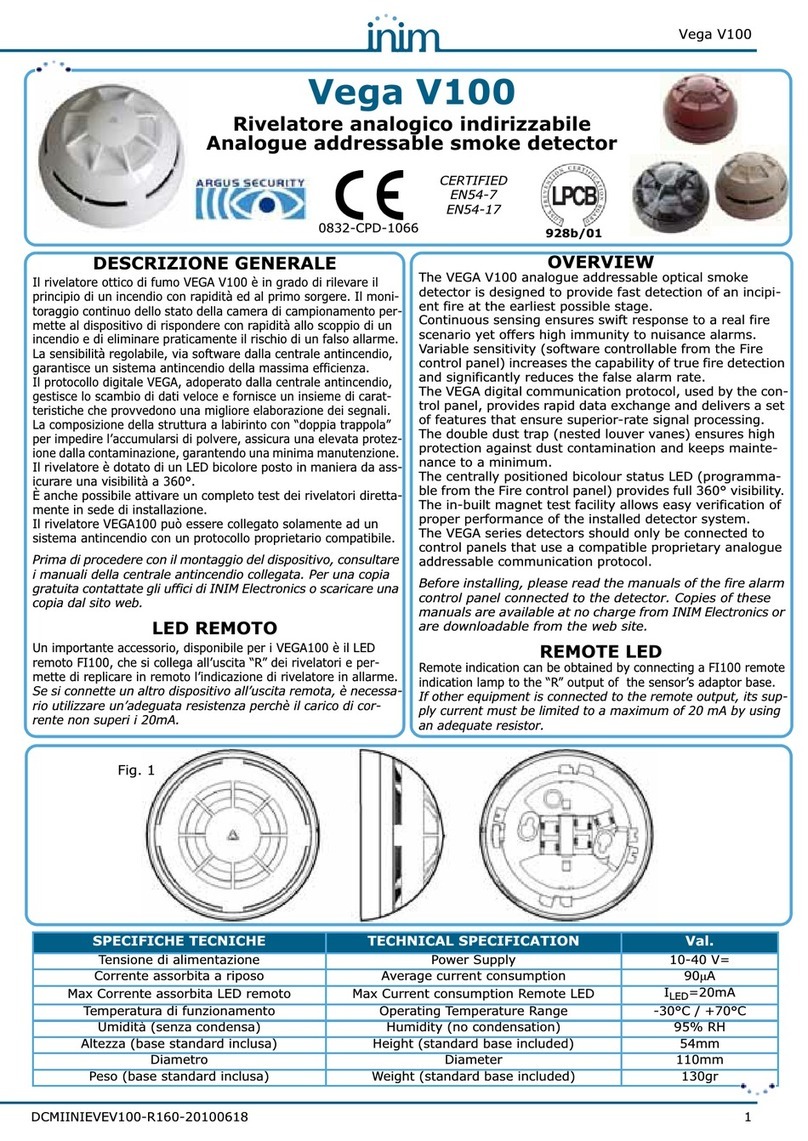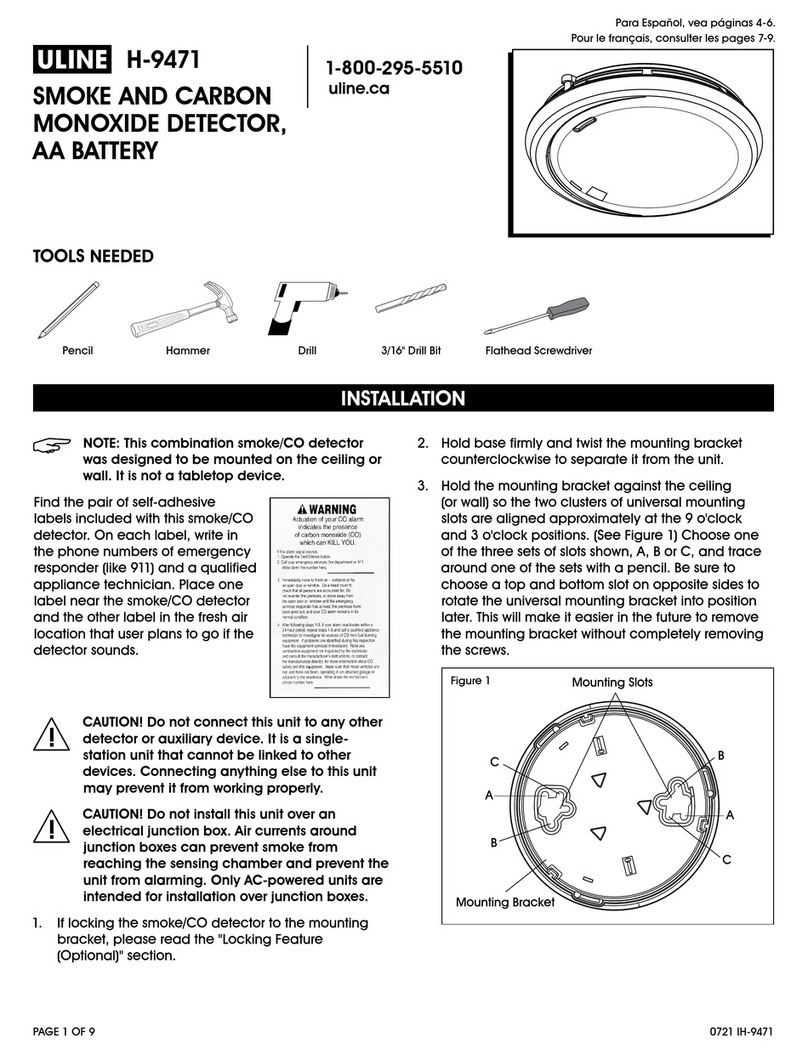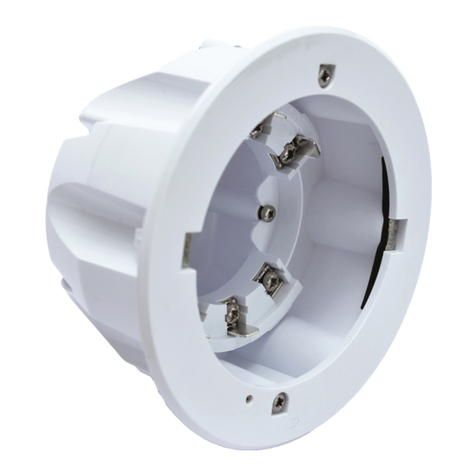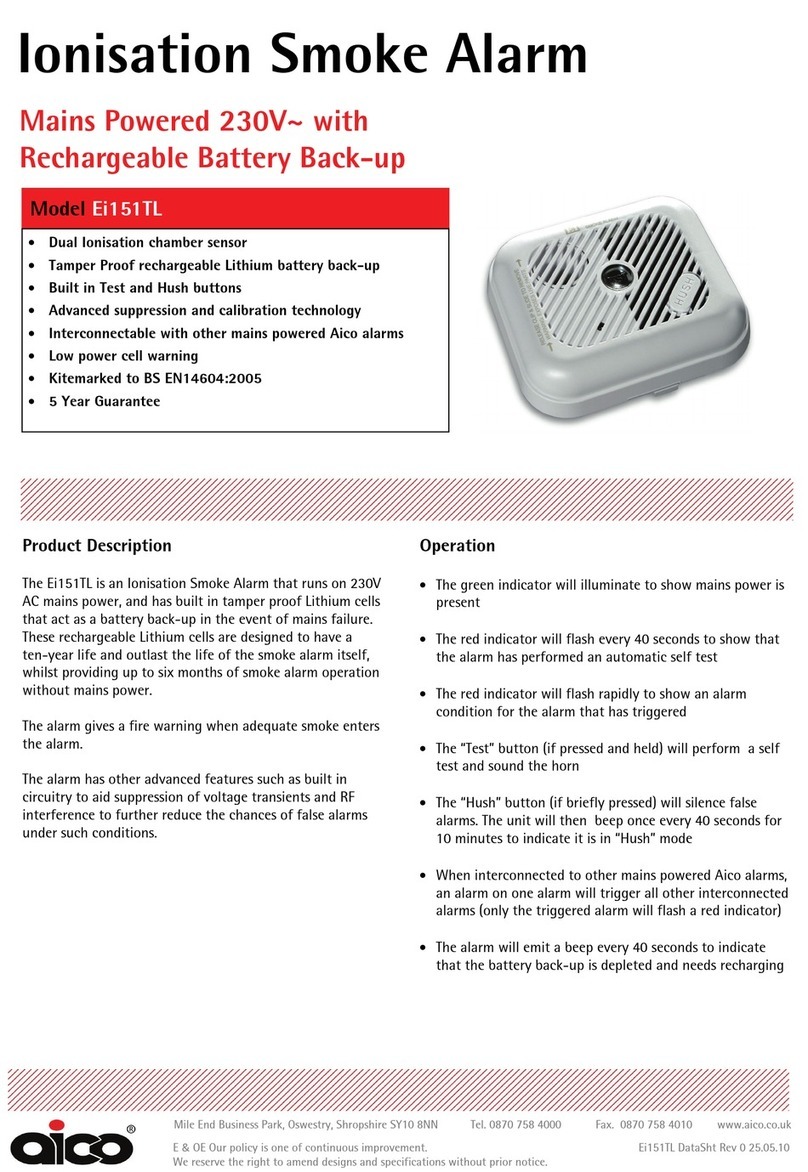eTIGER ES-D5B User manual

ES-D5B
Wireless Smoke Detector
EN 14604

2

3
Contents
Introduction . . . . . . . . . . . . . . 4
Box Content . . . . . . . . . . . . . . 4
Specications . . . . . . . . . . . . . . 5
Installation . . . . . . . . . . . . . . . 5
Connect the ES-D5B to your alarm system . . . . . . . . . 5
Operating test . . . . . . . . . . . . . . . . . 6
Mounting . . . . . . . . . . . . . . . . . . 6
Care . . . . . . . . . . . . . . . . . . . . 7
Installation guidelines . . . . . . . . . . . 8
Useful indications . . . . . . . . . . . . . . . . . . . 8
Optimal installation . . . . . . . . . . . . . . . . . . 8
Warning: unsuitable installation . . . . . . . . . . . . . . 11
Standards . . . . . . . . . . . . . . . 14
EN
Images, illustrations and text are non-contractual. ETIGER and the ETIGER logo are
registered trademarks and the property of ETIGER.
Copyright © 2019 ETIGER. All rights reserved.

4
LED indicator Test button
Introduction
This photoelectric smoke detector is designed to detect smoke
anywhere the detector is installed. It does not detect gas, heat or
ames. This smoke detector is designed to inform you in case of
start of re thanks to its built-in siren. It enables you to save precious
time and evacuate your house before the re spreads. However,
this smoke detector can only send an alert if located, installed, and
taken care of according to the instructions in this user manual.
Box Content
- ES-D5B x1
- Mounting bracket x1
- AA 1.5V batteries x2
- Documentation

5
Specications
- Internal antenna
- Radio-frequency: 433 MHz
- Transmission distance: ≥ 100 m (in open area)
- Smoke sensitivity: 0.09 ~ 0.16dB/m
- Volume: >85dB (at 3 m)
- Current (standby): <4 uA
- Current (operating): <40 mA
- Heat sensitivity: 54 ~ 70°C
- Powered by 2 x AA 1.5V battery (included)
- Battery life: ≥ 1 year
- Certication: EN 14604-2005
- Dimensions: Ø120 x 35.5 mm
-Reference: ES-D5B | Model: GS558
Installation
Install the batteries
Remove the back plate from
the detector by turning it
counterclockwise
Insert the batteries according to
the specications on the device.
Make sure to respect polarity !
EN

6
Connect the ES-D5B to your alarm system
Switch to Connection Mode on the control panel. Press and hold the
test button on the detector for 3 seconds. The control panel beeps
once: the detector is registered. If you hear two beeps, the detector
has already been connected.
Remark
For a continual protection of your home, the detector is assigned
to the 24h zone as per default settings. In case of low battery, the
detector will beep once every 40 seconds.
The detector is working: make sure the LED blinks once every 40
seconds. If so, the detector is in normal detection mode. When the
smoke detector triggers an alarm, the alarm will not stop until the
air is smoke-free again.
Operating test
Press and hold the test button for 6 seconds. The detector beeps 3
times every second, the LED indicator blinks fast and sends a signal
to the alarm system. To make sure the detector is working properly,
it is recommend to run this test once every six months.
52 mm
106 mm

7
Mounting
Make sure you have read carefully the instructions for optimal and
unsuitable installations before mounting the detector.
Select a suitable location (generally speaking, place the detector
at the center of the ceiling of the detection area) and screw the
mounting bracket to the selected location (see drawing below).
The detector is a small device that shall not be opened.
Insert the battery in its compartment and turn the plastic cover
clockwise. Press the test button and make sure the detector can
work properly.
Care
It is recommended to open the cover and remove the dust in the
detector’s smoke chamber at least once a year.
Remove the battery before cleaning the detector. Remove the dust
with a vacuum cleaner (attached to a soft brush). Carefully remove
dust in the detector components, especially in the openings of the
smoke chamber. Hand-wash the cover with a cloth dampened with
clean water and dry it with a lint-free cloth. Do not let any water in
the detector components.
Once your detector is clean, replace the battery, and close the cover.
Test the detector after cleaning.
EN

8
Installation guidelines
Smoke detectors must be installed according to the European
standard CE EN 14604. For a complete coverage of your home, the
detectors must be installed in every room, storage area, cellar, attic
and corridor. The minimum number of detectors to be installed is
one on each oor, one in every bedroom and one in the attic.
Useful indications
- Install one detector in every corridor next a bedroom room, as
shown in gure 1. In homes with two bedrooms, it is necessary to
install two detectors, as shown in gure 2.
- If your house or apartment has several oors, install a detector on
each oor, as shown in gure 3.
Optimal installation
We recommend a complete coverage and the use of additional
smoke detectors.
- Install a minimum of two smoke detectors for any type of home
- Install a detector in every bedroom
- Install a smoke detector at each end of a corridor giving access to
bedrooms, if this corridor is more than 12-meter long
- Install a detector in every room with a door that can be used as a
bedroom: smoke might be blocked by the door and the siren in the
corridor might not be loud enough to wake the person up if the
door is closed.

9
EN
Figure 1
Locations of
smoke detectors in
individual houses
with one bedroom
Smoke detectors for basic safety
Smoke detectors for optimal safety
Figure 2
Locations of smoke
detectors in single-
oor houses with
several bedrooms
Figure 3
Locations of smoke detectors in a mutlioor
house
Smoke detectors for basic safety
Dining room Kitchen
Living room
Bathroom
Bedroom
Living room Kitchen
Dining room
Bedroom
Bedroom
Bedroom Bedroom
Bedroom
Basement
Kitchen Living room
Bathroom Toilets
Toilets

10
- In the cellar, install the detectors near the stairs
- On the second oor, install a detector at the top of the stairwell
leading from the rst to the second oor.
- Make sure no door nor any obstacle will prevent the smoke from
reaching the detector
- Install additional detectors in your living room, your dining room,
in the common area, the attic and in the storage areas or in the
laundry room
- Install the smoke detectors as close as possible to the center of
the ceiling. If it is not possible, install the detector at the ceiling,
minimum 10 cm from the wall, as shown in gure 4.
- If you cannot install the detector at the ceiling and wall-mount is
authorized by the laws in your country, install the detectors 10 to 15
cm from the ceiling as shown in gure 4.
- If you have no choice but installing the detector on a sloped ceiling,
try to install the detector at a horizontal distance of 1 m from the
top of the ceiling, as shown in gure 5.
minimum
10 cm
Ceiling
Wall
maximum
15 cm
Optimal location
Acceptable location
Figure 4
Optimal and acceptable locations
for smoke detectors
center of
the ceiling

11
Warning: unsuitable installation
False alarms occur when the smoke detectors are installed in
locations where their use may be obstructed. In order to prevent
false alarms, do not install smoke detectors in the following
situations:
- In or near locations exposed to combustion particles, such as
kitchens with few windows or insucient ventilation, garages
exposed to exhaust fumes, near furnaces, hot water heaters, and
space heaters. Do not install smoke detectors less than 6 meters
EN
Smoke detectors for basic safety
Figure 5
Recommended location for an
installation under a sloped ceiling
Unsuitable installation
Figure 6
Recommended smoke detector locations
to avoid air streams with combustion
particles
1m
Horizontal distance from the
top of the ceiling
Kitchen
Bedroom
Bedroom Living room
Bath-
room

12
away from places where combustion particles are usually present
like kitchens. If the 6-meter distance cannot be respected, e.g. in a
mobile home, try to install the detector as far from the combustion
particles as possible, preferably on the wall. In order to prevent false
alarms, make sure these locations are well ventilated.
Important
Never deactivate the detector to prevent false alarms.
- Figure 6 highlights usual air streams circulating inside a kitchen
and the way potential combustion particles can reach the detector,
emphasizing the recommended and non-recommended locations
to install the detector.
- In damp areas or near bathrooms with showers, the moisture
present in humid air may enter the smoke chamber and turn into
droplets when cooling, which may cause false alarms. Install smoke
detectors at least 3 meters away from bathrooms.
- In very cold or very hot areas, including unheated buildings or
outdoor rooms. If the temperature goes above or below the
operating range of the smoke detector, the latter will not work
properly. The operating temperature range for your smoke detector
is -10°C to 50°C.
- In very dusty or dirty areas, dirt and dust may accumulate in the
smoke chamber and make the detector over-sensitive. Dust or
dirt may also block openings of the smoke chamber. Do not install
the detector near fresh air vents or in very drafty areas (next to
air conditioners, heaters or fans) as it may prevent smokes from
reaching the smoke detector.

13
- In stagnant air areas. Stagnant air areas are often at the top of a peaked
roof, or in the corners between ceilings and walls. Stagnant air areas
may prevent smoke from reaching the detector. Refer to gures 4 and
5 for recommended mounting locations.
- In insect-infested areas as insects entering the detector’s smoke
chamber may cause a false alarm. Where bugs are a problem, get rid of
them before putting up a detector.
- Near uorescent lights, electrical noise from uorescent lights may
cause false alarms. Install the smoke detector at least 1.5 meter from
such lights.
Warning
Never remove batteries to prevent false alarms. In case of alarm, open
a window or shue the air around the detector to help evacuating
the smoke from the detector. The alarm will turn o once the smoke
is gone. If false alarms persist, clean the detector according to the
instructions in this user manual.
Keep away from the detector when the alarm is ringing out. The alarm
is loud enough to wake you up in case of emergency. Long-term
exposure to the alarm may be harmful to your hearing.
EN

14
Standards
This product bears the selective sorting symbol for waste electrical
and electronic equipment (WEEE). This means that this product
must be handled pursuant to European Directive 2012/19/EU
in order to be recycled or dismantled to minimize its impact on
the environment. For further information, please contact your
local or regional authorities. Electronic products not included in
the selective sorting process are potentially dangerous for the
environment and human health due to the presence of hazardous
substances.
In compliance with European laws. This product is in compliance
with the essential requirements and other relevant provisions of
Directive 2014/53/EU and complies with the EN-14604 standard.
This product was designed and manufactured in compliance
with Directive 2011/65/EU of the European Parliament and of the
Council on the restriction of use of certain hazardous substances in
electrical and electronic equipment (RoHS Directive - RoHS) and is
deemed to comply with the maximum concentration values set by
the European Technical Adaptation Committee (TAC).
Manufactured in China.

15
Table des matières
Introduction . . . . . . . . . . . . . . 16
Dans la boîte . . . . . . . . . . . . . . 16
Caractéristiques techniques . . . . . . . . . . 17
Installation . . . . . . . . . . . . . . . 17
Inscrire le détecteur de fumée à la centrale d’alarme . . . . . . 17
Test de fonctionnement . . . . . . . . . . . . . . 18
Fixation . . . . . . . . . . . . . . . . . . . 18
Entretien. . . . . . . . . . . . . . . . . . . 19
Conseils d’installation . . . . . . . . . . . . 19
Conseils utiles . . . . . . . . . . . . . . . . . . . . 19
Installation optimale . . . . . . . . . . . . . . . . . . 20
Avertissements : installation inadéquate . . . . . . . . . . .22
Normes . . . . . . . . . . . . . . . . 26
FR
Photos, illustrations et textes non contractuels. ETIGER et le logo ETIGER sont les marques
déposées d’ETIGER.
Copyright © 2019 ETIGER. Tous droits réservés.

16
Témoin lumineux Bouton de test
Introduction
Ce détecteur de fumée photo-électrique est conçu pour détecter
la présence de fumée dans la zone de détection. Il ne détecte ni le
gaz, ni la chaleur ou les ammes. Ce détecteur de fumée est conçu
pour permettre un signalement précoce des départs de feu par
déclenchement de l’alarme sonore intégrée. Il permet de gagner un
temps précieux an d’évacuer les lieux avant que le feu ne se propage.
Toutefois, le détecteur de fumée rend cette alerte précoce possible à la
seule condition qu’il soit placé, installé et entretenu conformément au
présent manuel d’utilisateur.
Dans la boîte
- Détecteur de fumée x1
- Support de xation x1
- Documentation
- Piles AA 1.5V x2

17
Caractéristiques techniques
- Antenne interne
- Fréquence : 433 MHz
- Distance de transmission : ≥100 m (sans obstacle)
- Sensibilité à la fumée : 0.09 ~ 0.16dB/m
- Puissance sonore : >85dB (à 3 m)
- Tension (veille) : <4 uA
- Tension (fonctionnement) : <40 mA
- Sensibilité à la chaleur : 54 ~ 70°C
- Alimentation : 2 x piles AA 1.5V (incluses)
- Autonomie de la batterie : ≥ 1 an
- Certication : EN 14604-2005
- Dimensions : Ø120 x 35.5 mm
- Référence : ES-D5B | Modèle : GS558
Installation
Inserez les piles
Retirez la plaque arrière du
détecteur en la tournant sens
inverse des aiguilles d’une montre
Insérez les piles conformément
aux spécications de l’appareil.
Assurez-vous de respecter la
polarité!
FR

18
Inscrire le détecteur de fumée à la centrale d’alarme
Passez en mode de connexion sur la centrale d’alarme. Puis appuyez et
maintenez enfoncé pendant 3 secondes le bouton de test du détecteur.
La centrale d’alarme émet un bip pour conrmer la connexion. Si la
centrale émet deux bips, le détecteur a déjà été connecté.
A noter que le détecteur est réglé automatiquement en zone 24 heures
pour une surveillance permanente de votre habitation. En cas de batterie
faible, le détecteur émet un bip toutes les 40 secondes.
Le détecteur est en état de fonctionnement, vériez que la LED
clignote une fois toutes les 40 secondes. Cela signie que le détecteur
est en mode de détection normale. Lorsque le détecteur de fumée se
déclenche, il ne s’arrête pas avant que l’integralité de l’air soit propre de
toute fumée.
Test de fonctionnement
Appuyez et maintenez enfoncé le bouton de test pendant 6 secondes.
Le détecteur émet 3 bips à une seconde d’intervalle, le témoin lumineux
clignote rapidement et envoie un signal à votre centrale. Pour vous
assurer du bon fonctionnement du détecteur, il est recommandé de le
tester une fois tous les six mois.
Fixation
Assurez-vous d’avoir lu attentivement les consignes d’installation
52 mm
106 mm

19
optimale et d’installation inadéquate avant de xer le détecteur.
Choisissez une position adaptée (en règle générale, placez le détecteur
au centre du plafond de la zone de détection) et xez le panneau de
support de 106 x 106 mm à l’emplacement choisi à l’aide de vis.
Le détecteur est un appareil compact qu’il ne faut pas ouvrir.
Placez la batterie dans l’emplacement réservé, tournez dans le sens des
aiguilles d’une montre, puis appuyez légèrement sur le bouton de test et
vériez si le détecteur peut fonctionner normalement.
Entretien
Il est recommandé d’ouvrir le couvercle du détecteur et aspirer la
poussière dans la chambre de détection au moins une fois par an.
Retirez la pile avant de nettoyer le détecteur. Aspirer la poussière dans
les composants du détecteur avec soin, en apportant une attention
particulière à la chambre de détection. Lavez le couvercle du détecteur
avec un chion humide et essuyez avec un chion sans peluches. Ne
laissez pas pénétrer l’eau à l’intérieur des composants.
Une fois le détecteur propre, replacez la pile et fermez le couvercle.
Testez le détecteur après l’avoir nettoyé.
Conseils d’installation
Les détecteurs de fumée doivent être installés conformément à la norme
européenne CE EN 14604. Pour la couverture complète d’un logement,
les détecteurs de fumée doivent être installés dans toutes les pièces, les
zones de stockage, les caves et greniers ainsi que dans les couloirs. Au
FR

20
minimum un détecteur doit être installé par étage, et un détecteur doit
être installé dans chaque zone de couchage.
Conseils utiles
-Installez un détecteur dans le couloir à l’extérieur de chaque chambre,
comme indiqué dans la gure 1. Deux détecteurs sont nécessaires dans
les maisons comportant deux zones de couchage, comme indiqué en
gure 2.
-En cas de maison ou appartement à plusieurs étages, installez un
détecteur de fumée à chaque étage, comme indiqué en gure 3.
Installation optimale
Nous recommandons une couverture complète et l’utilisation de
détecteurs de fumée supplémentaires.
-Installez au minimum deux détecteurs par logement.
-Installez un détecteur dans chaque chambre à coucher.
-Installez un détecteur de fumée à chaque extrémité d’un couloir
desservant des chambres si celui-ci fait plus de 12 mètres de long.
-Installez un détecteur de fumée dans chaque pièce pouvant servir de
pièce de couchage et comportant une porte : la fumée est susceptible
d’être bloquée par la porte fermée et une alarme de couloir peut ne pas
réveiller la personne endormie si la porte est fermée.
-En sous-sol, installez les détecteurs à proximité de l’escalier.
-Au deuxième étage, installez un détecteur en haut de la cage d’escalier
menant du premier au deuxième étage.
-Assurez-vous qu’aucune porte ou autre obstacle ne viennent perturber
la propagation de la fumée vers le détecteur.
-Installez des détecteurs supplémentaires dans votre salon, votre salle à
manger, dans la zone commune, le grenier ainsi que dans les pièces de
stockage ou buanderies.
Other manuals for ES-D5B
1
This manual suits for next models
1
Table of contents
Languages:
Other eTIGER Smoke Alarm manuals
Popular Smoke Alarm manuals by other brands
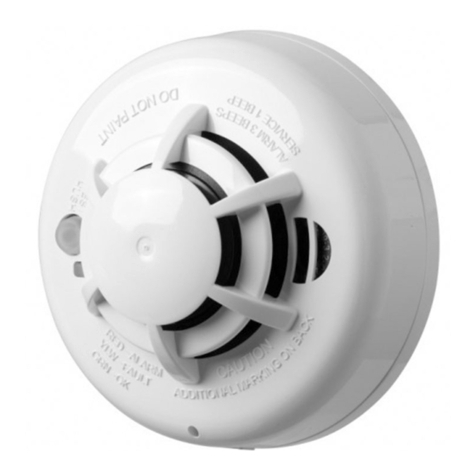
Bentel Security
Bentel Security ASD30 Installation and operating instructions
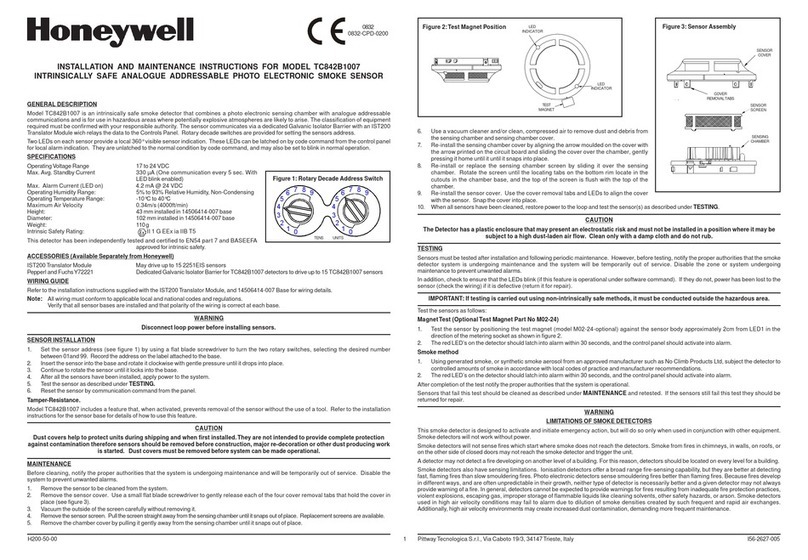
Honeywell
Honeywell TC842B1007 Installation and maintenance instructions
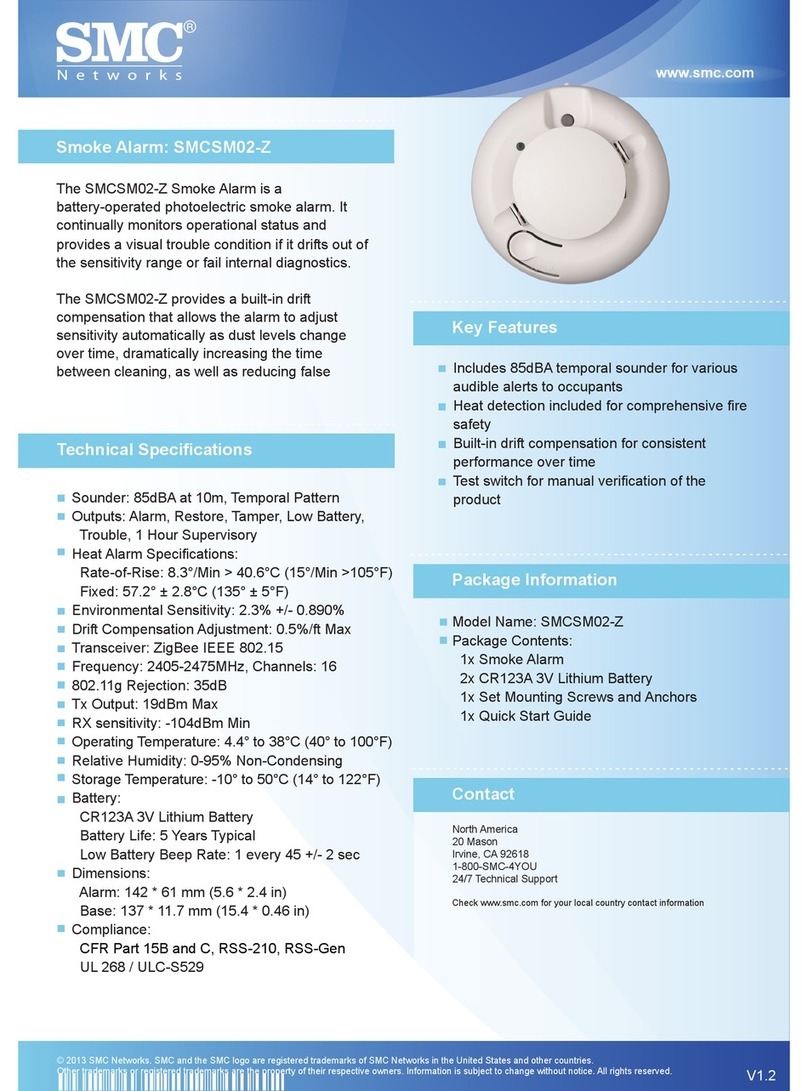
SMC Networks
SMC Networks SMCSM02-Z Specifications
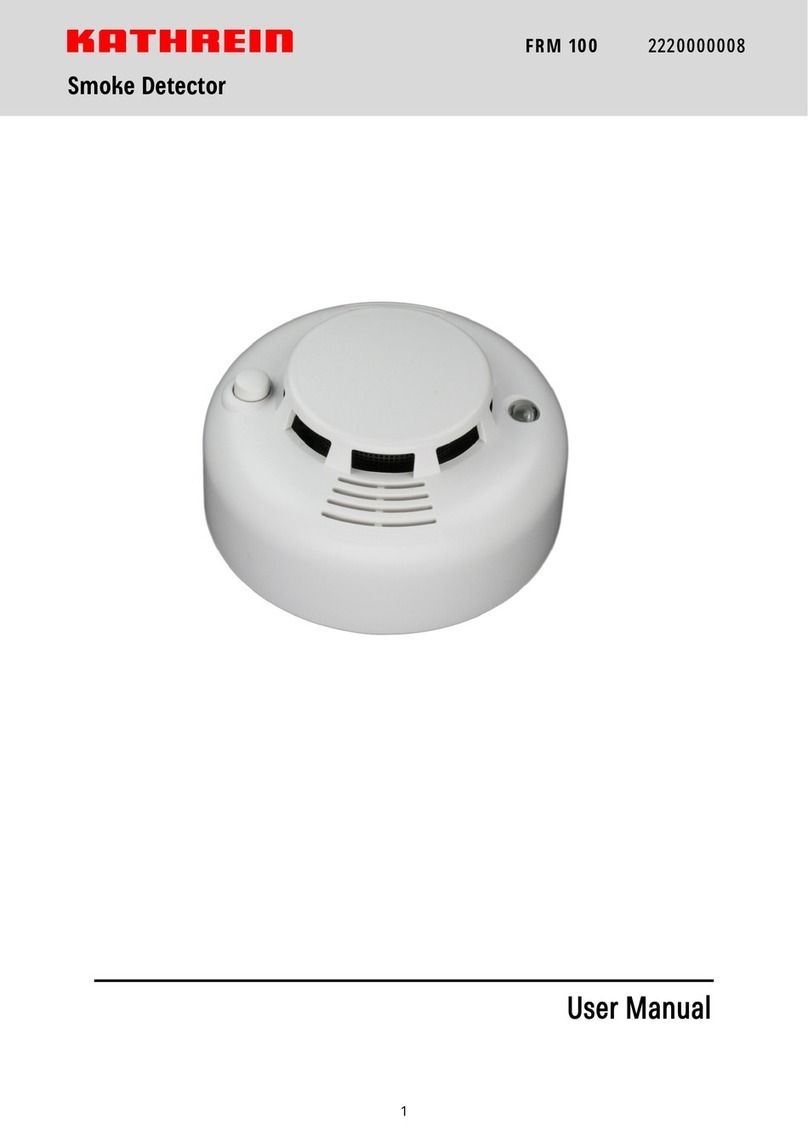
Kathrein
Kathrein FRM 100 user manual

System Sensor
System Sensor 1451 Installation and maintenance instructions
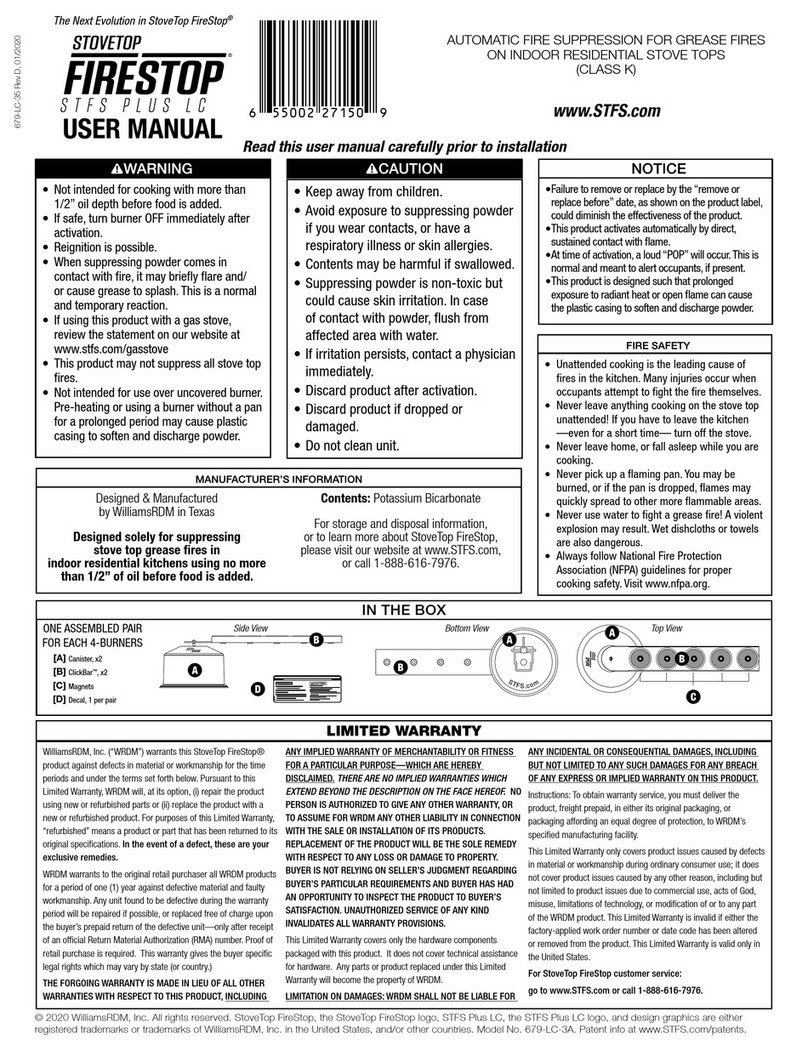
WilliamsRDM
WilliamsRDM Stove Top Fire Stop STFS PLUS LC user manual
